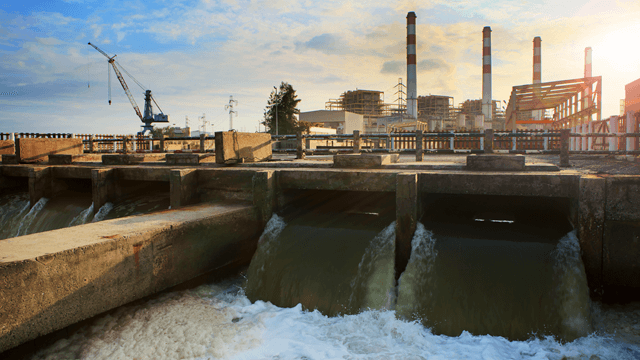Industrial Waste Water Treatment-- Eco-Friendly Solutions for Water Recycling
Wiki Article
Innovations and Advances in Industrial Waste Water Therapy Technologies
The landscape of commercial wastewater treatment is going through a transformative shift, driven by developments that enhance both effectiveness and sustainability. As regulative criteria advance, the assimilation of AI and machine learning into wastewater monitoring systems promises to simplify procedures and make sure conformity.Introduction of Drainage Therapy Technologies
Wastewater therapy modern technologies include a series of approaches designed to get rid of contaminants from commercial effluents before their launch into the environment. These modern technologies are vital for keeping eco-friendly equilibrium and ensuring compliance with environmental policies. The main classifications of wastewater treatment include physical, chemical, and organic methods, each serving unique functions based upon the nature of the impurities existing.

Organic therapy techniques employ microbes to weaken natural matter, making them particularly efficient for organic-rich effluents. Methods like triggered sludge and biofilm reactors harness the natural deterioration capabilities of germs, leading to substantial decreases in biochemical oxygen demand (FIGURE)
Advanced Filtration Methods
Advanced filtration strategies stand for an essential development in the world of commercial wastewater treatment, boosting the performance of pollutant removal procedures. Industrial Waste Water Treatment. These approaches incorporate a variety of modern technologies, including microfiltration, ultrafiltration, nanofiltration, and turn around osmosis, which give sequential barriers for different bit dimensions and chemical structuresMicrofiltration and ultrafiltration utilize membrane systems to remove suspended solids, bacteria, and bigger organic molecules, boosting the quality of effluent previous to additional treatment. Nanofiltration connects the space in between ultrafiltration and reverse osmosis, efficiently getting rid of natural compounds and divalent ions, thus minimizing the load on downstream procedures.
Reverse osmosis provides the highest degree of filtration by permitting just water and tiny particles to go through its semi-permeable membrane layers, making it optimal for redeeming top notch water from industrial effluents. Recent innovations in membrane layer innovation, consisting of the advancement of more fouling-resistant and durable materials, have actually considerably enhanced functional effectiveness and decreased costs.
Incorporating these sophisticated purification methods not just boosts the general treatment procedure however likewise adds to sustainability initiatives by allowing water reuse and source recuperation in commercial settings. (Industrial Waste Water Treatment)
Biological Treatment Advancements

Additionally, the growth of engineered biological systems, such as membrane bioreactors (MBRs), incorporates biological treatment with innovative membrane purification. This combination enables higher effluent top quality and reduced footprint, making it ideal for space-constrained industrial centers. Technologies in genetically crafted microorganisms have also arised, boosting the biodegradation of details contaminants, such as drugs and hefty metals, that are commonly testing to remove.
Additionally, the execution of bioaugmentation strategies, where advantageous germs are introduced to enhance the existing organic therapy procedures, has revealed appealing cause improving therapy efficiency. These innovations collectively indicate a pattern towards more reliable and lasting organic therapy techniques that can adjust to the progressing intricacies of industrial wastewater streams. As markets proceed to prioritize ecological compliance, these organic innovations will play a critical role in wastewater monitoring.

Source Recovery Approaches
In industrial setups, the integration of source go to my site recuperation methods has actually ended up being progressively crucial for enhancing sustainability and reducing waste. These methods concentrate on drawing out useful materials and power from wastewater streams, therefore transforming prospective contaminants right into reusable resources.One popular technique is vitamins and mineral recuperation, where nitrogen and phosphorus, typically existing in excess in wastewater, are recorded and exchanged fertilizers. This not only lowers ecological effects however likewise offers a round economic situation option for agricultural applications. In addition, innovations such as anaerobic food digestion permit for the conversion of natural waste right into biogas, a renewable resource resource that can balance out nonrenewable fuel source usage in industrial procedures.
Moreover, advanced filtration and membrane layer innovations facilitate the recovery of commercial by-products such as steels and salts. These recuperated products can be reintegrated right into manufacturing processes, reducing the need for virgin resources.
Future Fads in Waste Water Management
As markets increasingly focus on sustainability, the future of wastewater management is set to undertake significant makeovers. Technological improvements, such as expert system and artificial intelligence, will certainly enable more efficient monitoring and administration of wastewater systems. These technologies can anticipate maintenance needs, enhance therapy procedures, and improve decision-making, eventually reducing functional prices and environmental impact.Furthermore, the combination of round economic situation concepts will play a vital duty in wastewater try this web-site administration. Industries are expected to shift towards systems that not only deal with wastewater yet additionally recoup useful sources, such as nutrients, water, and power. This shift will certainly lessen waste and advertise the reuse of materials, straightening with global sustainability objectives.
Arising treatment techniques, such as membrane bioreactors and progressed oxidation procedures, will certainly further boost the efficiency of wastewater therapy, enabling for better effluents suitable for reuse. Furthermore, regulatory structures are most likely to evolve, stressing stricter criteria for wastewater discharge and encouraging industries to take on cutting-edge therapy remedies.
Final Thought
In final thought, the advancement of commercial wastewater therapy innovations demonstrates a significant change towards boosted performance and sustainability (Industrial Waste Water Treatment). Advancements in innovative filtering methods, organic treatments, and resource recovery approaches highlight the sector's commitment to ecological stewardship.The landscape of industrial wastewater therapy is going through a transformative shift, driven by innovations that improve both efficiency and sustainability.Wastewater therapy innovations encompass a range of techniques developed to remove contaminants from commercial effluents prior to their launch into the atmosphere.Using the power of biological procedures has linked here led to substantial innovations in the therapy of industrial wastewater.Additionally, the application of bioaugmentation approaches, where valuable microbes are introduced to improve the existing biological treatment procedures, has actually shown encouraging outcomes in boosting treatment performance. These innovations collectively symbolize a pattern in the direction of even more sustainable and reliable organic treatment methodologies that can adapt to the evolving intricacies of commercial wastewater streams.
Report this wiki page